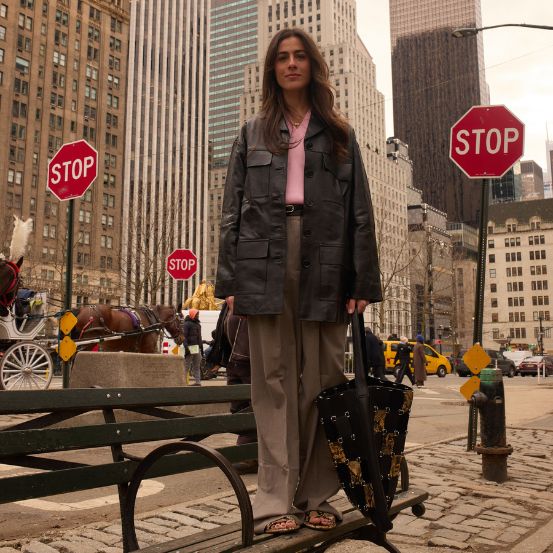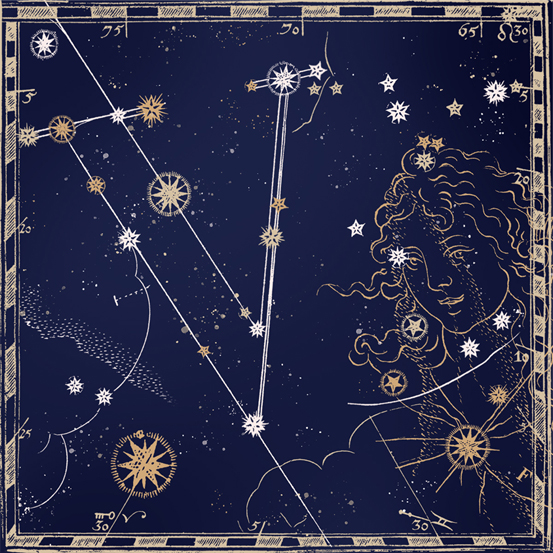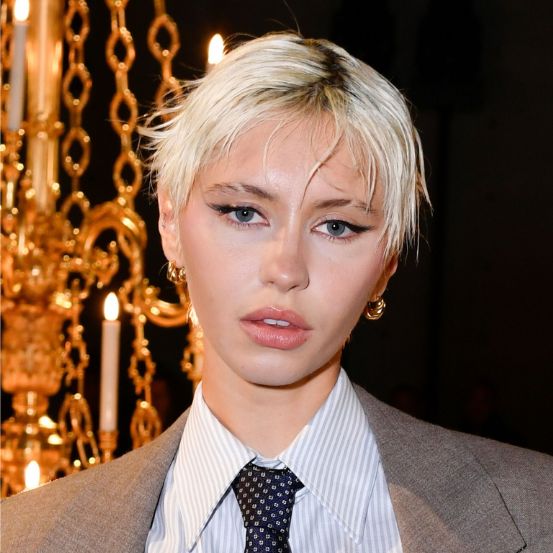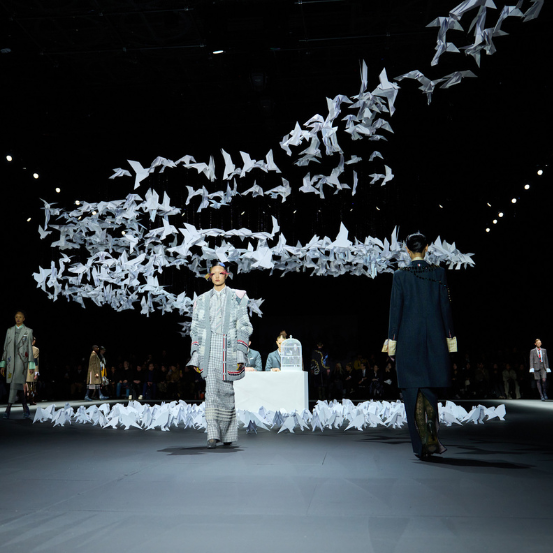The Icons Issue
Labeling someone an icon may seem like their ultimate goal, but in Twiggy's case it is somewhat a constraining term - as constraining as seeing her simply as the model who marked the Swinging Sixties. The woman of countless trades may have been propelled into the stratosphere of fame, but she never left there on her own and continued merit over time, detaching herself from her emblematic role of the 60s and multiplying her roles in a thousand and one facets. Yes, Twiggy is iconic, but she is also an example of how you gather achievements and never rest in the shadow of a timeless look.
Lesley Hornby (Lawson by marriage, since 1988) is one of the unmissable icons of the 60s. Her slender figure, her giant eyes, her penetrating gaze, her doll-like face with her pixie cut and her delicate poses influenced a generation of teenagers that goes beyond her time as a model. Even today, her images from that era remain as current as they are a testimony to that vibrant decade in London (and the world), in which the British woman was not a mere bystander, she was a central figure. And if the name Lesley doesn't trigger any kind of memory over the emblematic photographs of this star in the most eternal silhouettes of the 60s, the name Twiggy certainly will. “Only my sisters call me Lesley – it’s weird for me if someone else called me Lesley and I probably wouldn’t respond,” admits our cover girl. “I’ve been called Twiggy since I was 16 and it’s actually been really good to me.” In fact, hearing the nickname unlocks an archive of flashbacks, courtesy of the greatest photographers of the time (and others since) and which still feeds the mind, articles, retrospectives and collages made by young women who look at the then model as a example to be followed, not just in visual terms, but for her enviable trajectory that has been marked by many more forays into the arts beyond this historical era. “Sometimes it's a little frustrating, as I was actually only modeling for four years in the '60s before embarking on my acting and designer careers,” she shares, when asked about often being linked with that particular chapter when, in fact, it was just the first step on a tireless and unstoppable path. “But somehow, the 60s seem to hold a kind of magic for a lot of young people, so I understand.”
It's no surprise that, like Twiggy, the decade has its own nickname: the swinging sixties were a hurricane of revolutions, in Fashion in particular, and the London-born model was at the heart of it all. Named "The Face of 1966" by the Daily Express, referred to by British Vogue as the "extravagance that makes the sixties looks" and voted British Woman of the Year, in 1967 she was already modelling worldwide and doing covers for Vogue and Tatler. All thanks, as well, to her short haircut, which, interestingly, she wasn't even very convinced about taking chances on - she loved Jean Shrimpton and wanted long hair like hers, which is funny, because many throughout history would name her Shrimpton's successor, even with a hairstyle that was the opposite of her fellow model. “Yes, absolutely true”, Twiggy confirms, when we ask her to validate the story of her symbolic hairstyle. “but when the haircut was finished and I turned to look in the mirror, I absolutely loved it. Also, it was part of the look that catapulted me into becoming a top model.” Coco Chanel said that when a woman cuts her hair she is about to change her life and in Twiggy's case the phrase was literal: in January '66, at the age of 16, Twiggy had her hair dyed and cut short at London's Leonard of Mayfair, owned by the renowned hairdresser to the stars, who was looking for models to try out the new do, then photographed to be displayed in his salon. The Daily Express fashion journalist, Deirdre McSharry, saw the images and asked to meet the young woman, quickly triggering visibility and consequent career with an article published about Twiggy which would be just a tiny part in the story of recognition of the icon in the making. A month after the Daily Express article, Twiggy posed for her first Vogue photo shoot. A year later, she appeared in 13 different fashion shoots in the international editions of the title: in less than a year, Lesley, or rather Twiggy, had already established herself as the model of the moment - and one of the highest paid at the time -, appearing successively in fashion magazines and collecting cover after cover. Her rise was so apotheotic and her fan base so broad that in ’67 she launched her own clothing line, Twiggy Dresses, featuring the dress silhouettes she was so famous for in fashion photographs. Though, as any ordinary teenager, “I hated the way I looked,” she once said, in the context of being so young at the time, with the natural insecurities that come with age, “so I thought everyone had gone crazy.” Perhaps because of this incredulity that tags along a palpable humility in her posture and speech, she’s quick to say she doesn’t see herself as an icon, “I don't really think about it, it's other people's perception”, she shares.
Perhaps Twiggy doesn’t see herself as such, but History testifies to it. If, as she believes, “an icon is someone who stands the test of time in their specific field,” Twiggy has to be one of its most glaring examples. It is no surprise that, in 2009, when the MET hosted the exhibition The Model as Muse: Embodying Fashion, the museum's catalog even attested to her influence, describing Twiggy's figure as “the perfect frame for the androgynous styles that began to emerge in the 1960s”, leaving it up in the air whether it was Twiggy who was 'born' for these new trends or whether it was the trends that emerged to dress Twiggy, whose silhouette fueled looks that seemed (or were?) made for her. Captured by notable photographers such as Cecil Beaton, Richard Avedon, Melvin Sokolsky, Ronald Traeger, Bert Stern, Norman Parkinson, Annie Leibovitz, and Steven Meisel, Twiggy surpassed time, space, and even social barriers and went beyond borders, metaphorically and literally, crossing the Atlantic to New York, where she continued to collect successful headlines: she arrived in the city that never sleeps in March 1967, and The New Yorker, Life and Newsweek reported on the "phenomenon" that was her arrival. Twiggy was, according to feminist critic Linda Delibero, “the most visible commodity Britain produced that year, and [America] generously lived up to the hype, gobbling up little Twiggy pens, Twiggy lunch boxes, Twiggy eyelashes, a variety of cosmetics endorsed by Twiggy “. So much so that in 1969, at just 20 years old, Twiggy was selected as the subject of one of the first English editions of the biographical television series This Is Your Life”. Was it hard to deal with all this attention? “I’ve been in the public eye since I was 16, so I got pretty used to it,” she explains. “In the first few days it was very exciting, because before I was discovered I was literally a schoolgirl. My family life has always been very important to me, earlier on with my parents and sisters and later with my husband and daughter and now grandchildren so I think they have kept me very grounded. I feel I’ve been very fortunate in my career as I have been given the chance to move from modelling into acting, singing and performing. Yes, the move from modelling into performing happened organically as I was given the chance to star in my first film ‘The Boyfriend’, by the English director Ken Russell, for which I won two Golden Globe awards. From then on I continued my career in Film, TV, recording albums and performing on stage”, she says, attesting that it is very narrow to classify her solely as a model and solely as an icon from the 60s.
Indeed, after four years as a model, Twiggy retired in 1970 (although talking about “retirement” is a false assumption, as Twiggy continued and continues to grace the pages and covers of magazines, albeit with a different role and status), stating that "you can't be a hanger for life!" She even mentioned years later that her career had more to do with that famous photo of her with her funny painted eyelashes, which appeared in the Daily Express under the title The Face of '66' than with any promotional efforts, but even though the quote might suggest that it was all a stroke of luck, everyone knows that luck takes a lot of work and the career that unfolded after this fashion makeover proves that Twiggy is much more than someone who was in the right place at the right time. The friendship with director Ken Russell sparked her career as an actress, which unfolded into starring in a variety of roles on stage and screen, achievements she considers some of her favorites in her life: “I feel very fortunate that I’ve been given the opportunity to do all the things I’ve done and continue to do, i.e. modelling, acting, singing, designing clothes, etc. I enjoy all the things I do, so it’s hard to pick a favourite. Every project I embark on I love doing, but if I had to pick one thing, it was probably starring on Broadway in a big musical, ‘My One and Only’, for which I was nominated for a Tony award. Having not done lot of theatre it was quite a challenge and pretty scary, but going out in front of 1500 people every performance was exhilarating.” Step by step, she ventured into music, as well, and, in 1976, signed a contract with Mercury Records and released the albums Twiggy and Please Get My Name Right, with pop and country music styles, which sold quite well, reaching 33rd place in the UK charts, even earning her a Silver Record. In the meantime, she also appeared on the cover of David Bowie's seventh album, Pin Ups (1973), after having already been mentioned by the singer on the previous album Aladdin Sane (1973), in the theme Drive-In Saturday: "She'd sigh like Twig the wonder kid.” And if that’s not iconic, we don’t know what is.
Collecting crafts seems to be the mark of the original influencer (yes, influencer - after all, if being an influencer means not being stuck in a single profession, Twiggy will be the ultimate precursor of it), who then balanced herself in all these areas over the years, juggling stages and screens and musical albums (she released 10, the most recent in 2011, titled Romantically Yours), and even Fashion campaigns (now as the icon more than as a professional model), with an enviable skill in balancing everything together and never leaving the Arts scene, in a career - and life - full of events. It is no wonder, therefore, that at the end of the 90s she had already released an autobiography and also that she has just premiered to a select audience (it should arrive in cinemas worldwide in the spring of 2025) a documentary entitled Twiggy, and directed by her friend, producer, actress, fashion designer and director Sadie Frost. “The new documentary has just premiered at the London Film Festival and the Rio de Janeiro Film Festival, which is very exciting. It got a great reception at LFF and some fabulous reviews. It came about when Sadie appeared on my podcast ‘Tea with Twiggy’, and the idea was born from our conversation. That was two years ago and I worked closely with Sadie, and I think she did a wonderful job and I hope people enjoy the documentary,” she shares, adding that the documentary is very emotional to watch, but at the same time, “quite strange to see your life unfolding before you.” And in this retrospective, can you single out three highlights? “It would be making the film The Boy Friend, starring on Broadway in the musical My One and Only and receiving the title of Dame in 2019 for my services to the arts and charity from Prince Charles, now King Charles III. It was an incredible honor and an extraordinary day. (…) It was wonderful and overwhelming, because it was totally unexpected. But I was very proud to receive such an honor from our Royal Family.”
No need for the title to know she’s a Dame: the world had already consecrated her as an icon long before all the awards, recognition and honors she would accumulate, the result of an artistic contribution that is far from being a coincidence. Talking about Twiggy is understanding that there may be no parallel to her impact in today’s world, even if the visibility resulting from social networks is infinitely greater. Can we still talk about icons, in current times, when the passage through notoriety seems to be so fleeting? “I think the most important way to answer this question is to say that it’s more important to be good at what you do and work and try hard,and follow your dream. It’s not really about being famous, although that often goes with the territory. which can be a good thing or a bad thing depending on how it is handled”, she says. If the Twiggy of the 60s had been “born” in this Internet era, she says it would have been very different, although can't imagine in what way, without being an idle conjecture. She assures that the “60s were a great time to be young”, but guarantees that she’s not nostalgic for it, “I have always lived in the present”. Maybe that's why she (returning to this idea of Twiggy - now 75 years old - as more than an icon, a role model) is a woman without fear of the passing of the years, something that can be felt in her energy and posture: “There’s absolutely nothing you can do about getting older - it happens to us all. So I try to embrace it, and look after myself. Keeping fit is extremely important and my chosen exercise is Pilates, and long country walks. Playing with my adored grandchildren keeps my brain active and my body fit - kids have so much energy Also a healthy diet is very important, and I love to cook. I truly believe you are what you eat so I try to buy organic produce & love experimenting with new dishes. My guilty pleasure is chocolate!” Her inexhaustible aura returns to the pages and cover of Vogue, in this issue dedicated to icons, which sees her return, once again, to poses and photographs: “I was thrilled to be invited by Vogue Portugal, to do this cover shoot. I love working with Rachel Smith, the photographer-she’s brilliant. It was a fun shoot, and the photos are great”, ensuring that going back to her roots “never gets boring. I love working with talented people. And doing a photoshoot for Vogue is always exciting.” In this issue of icons, she points out “Greta Garbo, Audrey Hepburn and Paul McCartney” as some of her own and assures that she has non-iconic behaviors, such as “sewing, knitting, doing jigsaw puzzles and cooking”. Being an icon, does Twiggy also feel this pressure to be a role model? “I never set out to be a role model, but sometimes it goes with the territory. I believe you treat people how you wish to be treated.”
Translated from the original in Vogue Portugal's The Icons Issue, published November 2024. Full story and credits in the print issue.
Most popular
.jpg)
Gracie Abrams em Lisboa: "Foi libertador ser um pouco mais 'barulhenta' nesta fase da minha vida"
13 Feb 2025

A Mango Selection apresenta a sua nova coleção: eis as escolhas de Vicky Montanari
12 Feb 2025

Relacionados

Será que o cabelo retém traumas? A explicação psicológica do porquê de um corte de cabelo ser transformador após o fim de uma relação
18 Feb 2025

.jpg)




